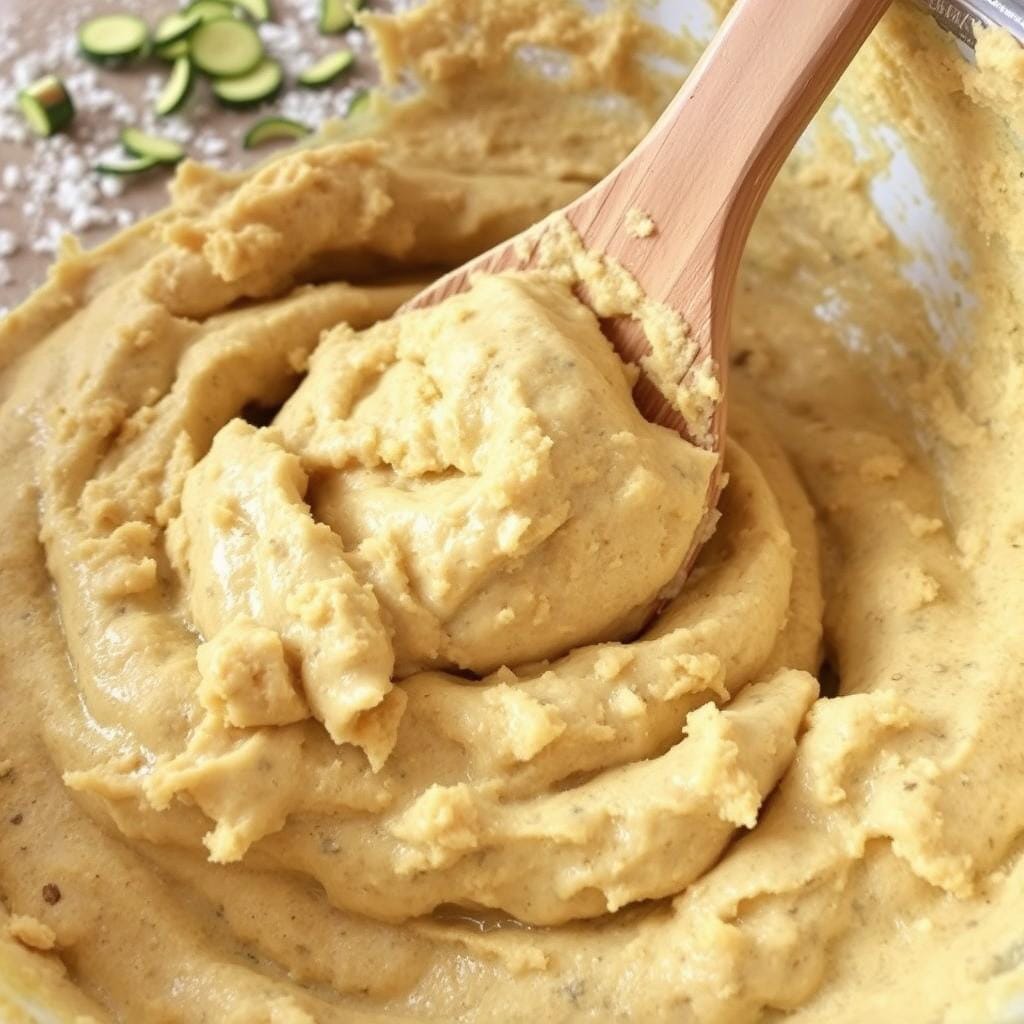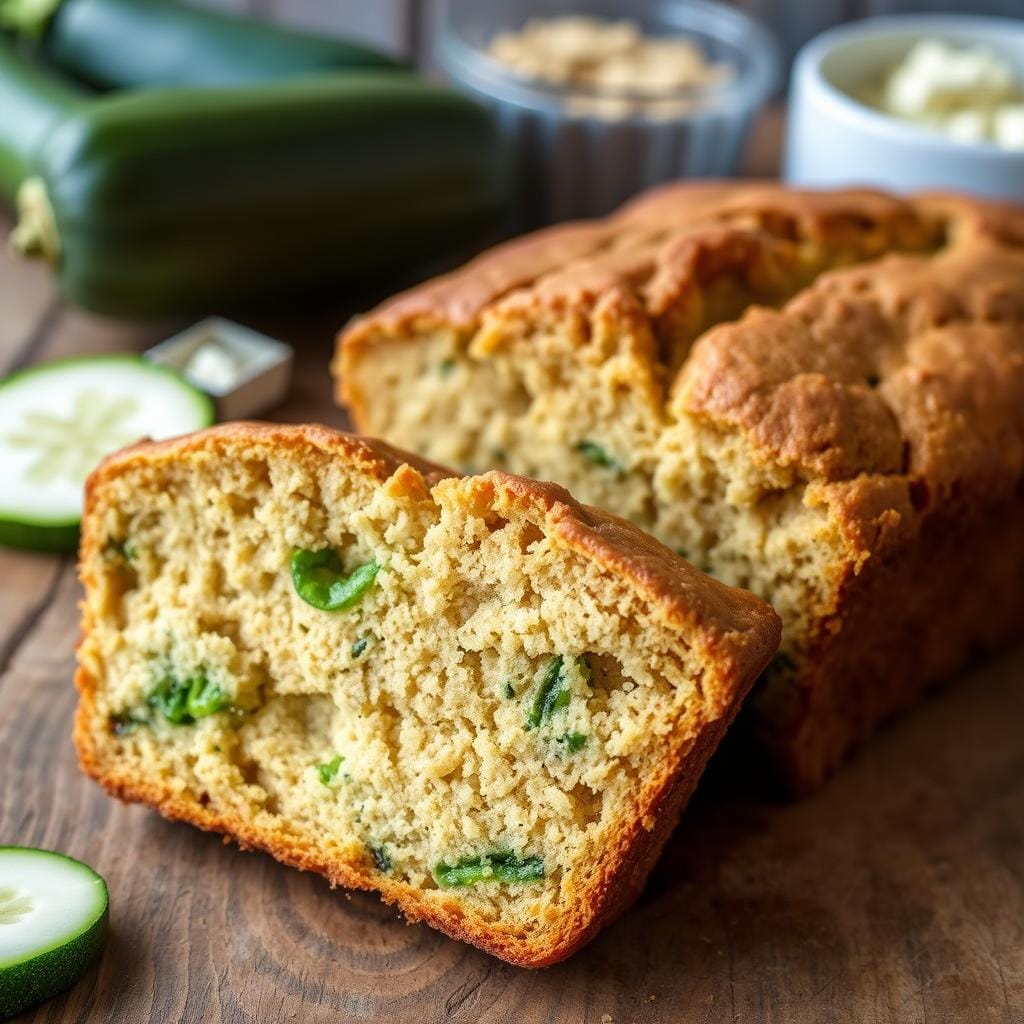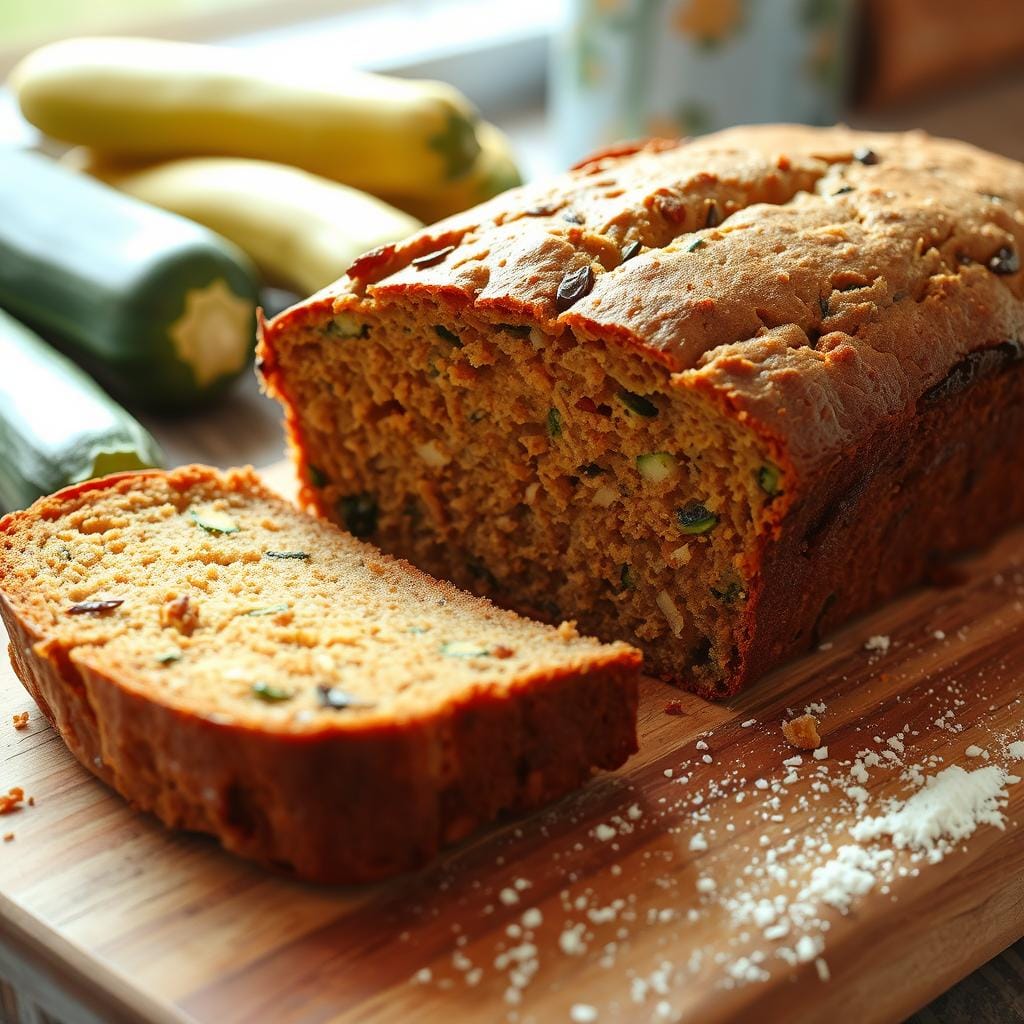As a passionate home baker, I’ve faced the disappointment of a rubbery zucchini bread. It’s not the light, fluffy treat we all dream of. But don’t worry, I’m here to share the secrets behind this issue. I’ll give you the tips you need to make your zucchini bread just right.
Key Takeaways
- Understand the science behind gluten development and its impact on zucchini bread texture.
- Identify common mistakes that can lead to a rubbery quick bread and how to avoid them.
- Discover the critical role of proper mixing techniques in achieving the ideal texture.
- Learn how to choose the right flour and properly prepare the zucchini for your recipe.
- Explore the importance of temperature and timing in baking perfect zucchini bread.
Why Did My Zucchini Bread Turn Out Rubbery?
If your zucchini bread turned out rubbery, you’re not alone. Several factors can cause this issue. Knowing what went wrong can help you fix it and make a soft, moist bread.
Overmixing the batter is a big problem. It makes too much gluten, leading to a tough bread. This messes up the bread’s light and airy texture.
Too much moisture in the zucchini can also cause issues. If you don’t drain the zucchini well, it can make the bread too wet. This throws off the recipe’s balance.
Wrong ingredient ratios are another issue. Too much flour or not enough sugar or leavening can make the bread rubbery.
By understanding these problems, you can adjust your recipe and methods. This will help you make a soft, moist, and tasty zucchini bread every time.

“The key to perfect zucchini bread texture is finding the right balance of ingredients and mixing techniques.”
The Science Behind Perfect Zucchini Bread Texture
Getting the perfect zucchini bread texture is more than just following a recipe. It’s about knowing the science behind the ingredients and baking methods. Let’s explore the three key elements: gluten, moisture, and leavening agents.
Understanding Gluten Development
Gluten, a protein in wheat flour, is vital for your bread’s texture. When flour meets liquid, gluten forms a network. This network traps air, making the bread rise and giving it texture. But, too much gluten can make the bread tough and rubbery.
Role of Moisture Content
The excess moisture from zucchini can affect your bread’s texture. Zucchini adds moisture and flavor but can mess with gluten if not balanced right. Finding the perfect moisture balance is key for a soft crumb.
Impact of Leavening Agents
Baking soda and baking powder are the leavening agents in zucchini bread. They create carbon dioxide bubbles, making the bread light and airy. But, using the wrong amount can make the crumb uneven or dense.
| Ingredient | Role in Texture |
|---|---|
| Gluten | Provides structure and traps air bubbles, but too much can lead to a rubbery texture |
| Moisture | Adds softness, but excess can disrupt gluten development and lead to a dense crumb |
| Leavening Agents | Create air bubbles for a light, airy texture, but improper use can cause uneven or dense results |
Knowing the science behind zucchini bread texture is the first step to baking perfection. Focus on gluten, moisture, and leavening agents. This way, your zucchini bread will always have a soft, tender crumb.

Common Mistakes That Lead to Rubbery Texture
Getting the perfect zucchini bread texture is a challenge, even for seasoned bakers. Knowing the common mistakes helps make a soft, moist, and tasty loaf every time.
Overmixing the batter is a big mistake. It makes the bread tough and chewy because of too much gluten. Mix the ingredients gently, without stirring too hard.
Using too much moisture-rich zucchini without draining it is another problem. Zucchini has a lot of water, which can make the bread soggy. Make sure to drain and dry the shredded zucchini well.
Choosing the wrong type of flour can also mess up the texture. All-purpose flour is usually the best choice. It has the right amount of gluten and structure. But using bread flour or whole-wheat flour can make the bread denser and rubbery.
By avoiding these common mistakes, you can make sure your zucchini bread is soft, moist, and delicious every time.
The secret to perfect zucchini bread texture is a mix of the right ingredients, careful preparation, and gentle mixing. With a bit of care, you can bake a zucchini bread that’s not only tasty but also looks great.
The Critical Role of Proper Mixing Techniques
Making the perfect zucchini bread is not just about the ingredients. It’s also about how you mix them. The right mixing techniques are key to avoiding a rubbery or dense texture. We’ll look at signs of overmixing, the best folding methods, and how to mix wet and dry ingredients for a light bread.
Signs of Overmixing
Overmixing can make your zucchini bread tough and chewy. It happens when you mix too much, developing too much gluten. Look out for a dense batter and a bread that’s not as airy as it should be.
Correct Folding Methods
To avoid overmixing, use a gentle folding technique. Fold the batter with a spatula, making sure to get all sides of the bowl. Don’t use a mixer or over-stir, as this can make the bread tough.
Incorporating Wet and Dry Ingredients
When mixing wet and dry ingredients, do it in the right order. Mix the dry ingredients first, then add the wet ingredients, folding gently. This helps prevent overmixing batter and ensures even moisture.
Mastering proper mixing techniques will help you bake a zucchini bread with the perfect texture. Remember, be gentle, patient, and avoid over-mixing at all costs.
Choosing the Right Flour for Your Zucchini Bread
Choosing the right flour is crucial for perfect zucchini bread. Different flours, like all-purpose, whole wheat, and gluten-free, each have their own effects. Knowing how they work helps avoid quick bread texture issues and ensures your bread is moist and tender.
All-Purpose Flour: A Versatile Choice
All-purpose flour is a favorite for zucchini bread. It gives a balanced texture and a soft crumb. But, using too much can make the bread rubbery and dense.
Whole Wheat Flour: Hearty and Nutritious
Whole wheat flour adds a nutty taste and a denser texture. It’s healthier but may need more liquid and leavening to avoid a wrong flour problem.
Gluten-Free Flour Blends: Accommodating Dietary Needs
Gluten-free flour blends are great for those with gluten sensitivities. Made from rice, almond, or coconut flour, they make a moist bread. But, they might need extra binding agents to avoid a crumbly texture.
The right flour choice depends on your taste, dietary needs, and desired texture. Try different flours and ratios to find the perfect mix for your moist, tender zucchini bread.
“The right flour can make or break your zucchini bread. Choosing wisely is the first step to achieving that perfect quick bread texture.”
Proper Preparation of Zucchini
Getting your zucchini ready right is key to making great zucchini bread. Too much moisture can make the bread feel rubbery or dense. Let’s look at how to fix this and make your bread just right.
Draining Excess Moisture
Too much moisture from the zucchini can ruin your bread. To fix this, drain the shredded zucchini well before mixing it into the dough. Use a colander or cheesecloth to press out the extra water.
Correct Grating Techniques
How you grate the zucchini matters too. Go for a fine, even grate. This helps the zucchini mix well with the other ingredients. Big chunks can make the bread dense.
Measuring Shredded Zucchini
Measuring the zucchini correctly is also important. Stick to the recipe’s amount. The right mix of zucchini and other ingredients keeps the bread moist and tasty.
| Proper Zucchini Preparation | Benefits |
|---|---|
| Drain excess moisture from shredded zucchini | Prevents a rubbery or dense crumb |
| Use a fine grate for even distribution | Avoids dense spots in the final loaf |
| Measure shredded zucchini accurately | Maintains the ideal moisture balance |
By following these tips, you’ll make a delicious, fluffy zucchini bread. Paying close attention to how you prepare the zucchini makes a big difference.
“The key to perfectly moist and fluffy zucchini bread is in the proper preparation of the zucchini itself.”
Temperature and Timing: Keys to Perfect Baking
Getting the right zucchini bread texture is all about the baking process. The oven temperature and baking time are key. If you underbake, the bread might be gummy. Overbaking makes it dry and tough.
To get it right, know the best baking conditions. Preheat your oven to 350°F (175°C). This helps your bread bake evenly and get a nice crust. Also, watch the baking time closely. It changes based on your loaf pan size and zucchini moisture.
- Use a toothpick or cake tester to check for doneness. Insert it into the center of the bread; if it comes out clean, your zucchini bread is ready to be removed from the oven.
- Avoid the temptation to open the oven door frequently, as this can cause the bread to sink or become unevenly baked.
- Allow the bread to cool completely on a wire rack before slicing to prevent the texture from becoming gummy or tough.
Mastering temperature and timing ensures your zucchini bread turns out perfect. Avoid underbaking and overbaking issues. The secret is in your oven and your attention to detail.
| Baking Condition | Potential Texture Issues | Recommended Solution |
|---|---|---|
| Underbaking | Gummy, undercooked interior | Increase baking time and monitor closely |
| Overbaking | Dry, tough crumb | Reduce baking time and check for doneness earlier |
The Impact of Recipe Modifications on Texture
When baking zucchini bread, texture is key. But what if you need to change the recipe for dietary reasons or personal taste? We’ll look at how changes can affect your bread’s texture. We’ll also give tips to keep it just right.
Substitution Guidelines
Changing ingredients can really change your bread’s texture. Here are some tips to keep it moist and soft:
- Choose a flour with similar gluten content for the right structure. All-purpose and whole wheat are good choices.
- Use 25-30% less nut or alternative flour and add an extra egg or oil to keep it moist.
- Replace oil with applesauce or mashed banana in equal amounts for a moist texture.
- Adjust baking soda or powder based on the new flour to avoid a dense bread.
Adjusting for Dietary Restrictions
It’s possible to make zucchini bread that fits dietary needs without losing texture. Here’s how:
- For gluten-free, use a quality blend and add an extra egg or oil to avoid dryness.
- Replace butter with coconut oil, vegetable oil, or plant-based butter for dairy-free.
- Use flax or chia “eggs” (1 tablespoon ground flax or chia with 3 tablespoons water) for vegan bread.
Remember, adjusting recipes takes practice. Don’t be afraid to try different combinations until you get the moist, tender texture you want.
Storage Methods That Maintain Ideal Texture
Keeping your homemade zucchini bread fresh is key, whether you eat it now or save it for later. The right storage methods are crucial for keeping the bread moist and tender. Let’s look at the best ways to store your zucchini bread and keep it perfect.
Short-Term Storage for Freshness
To enjoy your zucchini bread within a few days, store it at room temperature. Cool the bread and put it in an airtight container or wrap it in plastic wrap. This keeps the bread moist and prevents it from drying out. Don’t store it in the fridge, as it can become rubbery and unappealing.
Freezing for Long-Term Enjoyment
Freezing is great for enjoying your zucchini bread over a longer time. Slice the bread and lay the slices on a baking sheet. Once they’re frozen, put them in an airtight container or freezer bag. This stops the bread from sticking together, making it easy to thaw as needed. To enjoy, thaw at room temperature or warm in the oven for a few minutes.
| Storage Method | Ideal Duration | Tips for Best Results |
|---|---|---|
| Room Temperature | 3-4 days | Store in an airtight container or wrap tightly in plastic |
| Freezer | 2-3 months | Slice bread and freeze in a single layer before storing in an airtight container |
By following these storage tips, you can enjoy your homemade zucchini bread for days or weeks. Remember, proper storage is essential for avoiding zucchini bread troubleshooting issues and keeping the quick bread texture just right.
Troubleshooting Other Texture Issues
Getting the perfect texture in zucchini bread can be tricky. But, with some tips, you can fix common problems like dense spots and uneven baking. Let’s look at some practical solutions to make your zucchini bread moist and delicious all the way through.
Dealing with Dense Spots
Dense, gummy spots in your zucchini bread might be from too much moisture or mixing too much. To avoid this, make sure to drain excess moisture from the shredded zucchini before adding it to your recipe. Also, mix the batter gently to prevent a dense, rubbery texture.
Fixing Uneven Baking
Uneven baking, where the edges are overdone and the center is underbaked, is common. To fix this, use the right baking pan and adjust the oven temperature and time. Try different pan sizes and shapes to find the best fit for your recipe. Also, rotate the pan halfway through baking to ensure even heat and texture.
By using these troubleshooting tips, you’ll be able to bake zucchini bread with a perfect texture. Your family and friends will love it.
Conclusion
Learning how to make perfect zucchini bread is a mix of science and skill. Knowing what makes it rubbery, like gluten, moisture, and leavening, helps. This way, you can make sure your bread is always light, fluffy, and moist.
It’s important to mix ingredients right, choose the best flour, and prep the zucchini well. Also, watch the temperature and timing while baking. And don’t forget to store your bread properly to keep it fresh.
Now you know how to fix zucchini bread that turned out rubbery. Use this knowledge to bake loaves that everyone will love. Enjoy the process of baking and share your delicious creations with others. Happy baking!

